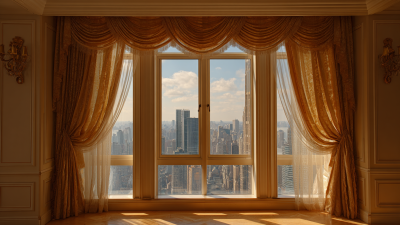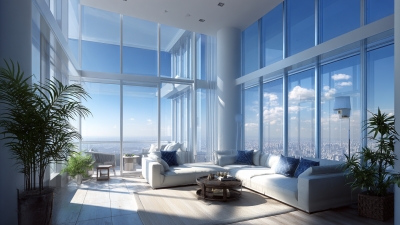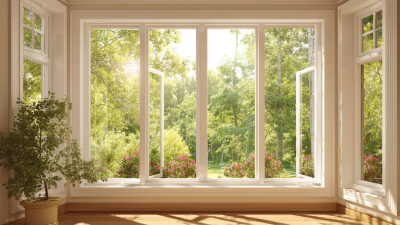Innovative House Door Designs That Transform Your Home and Boost Energy Efficiency
In today’s sustainable living landscape, the importance of energy-efficient house doors cannot be overstated. According to the U.S. Department of Energy, nearly 30% of a home's heating energy can escape through inefficient doors and windows, making proper selection and design crucial for homeowners looking to improve their energy efficiency. Innovative house door designs not only contribute to aesthetic appeal but also play a significant role in reducing energy consumption and enhancing overall home comfort. With advancements in materials and technology, contemporary doors are now available in various styles that provide superior insulation, security, and durability. As homeowners increasingly seek to merge functionality with design, exploring the latest trends in house doors can lead to transformative upgrades that optimize both beauty and utility in their living spaces.

Table of Contents
[Hide]
Creative Materials for Modern Door Designs That Enhance Curb Appeal
When it comes to enhancing the curb appeal of your home, the front door plays a pivotal role.
Modern door designs now incorporate creative materials that not only look stunning but also improve
energy efficiency. According to a report by the U.S. Department of Energy,
upgrading to an energy-efficient door can reduce heating and cooling costs by up to 20%.
Materials such as fiberglass and steel offer incredible insulation properties, preventing drafts and keeping
your home comfortable year-round.
Choosing the right door material doesn't just elevate your home’s aesthetic; it also adds to its overall value.
For instance, a well-designed fiberglass door can mimic the appearance of wood while providing superior
durability and energy savings. The latest trends also highlight the use of reclaimed materials for a rustic look,
appealing to eco-conscious homeowners. With data from the National Association of Realtors
indicating that exterior doors can recoup over 70% of their cost upon resale,
this choice contributes to both beauty and investment.
Tips: When selecting your door, consider colors that
complement your home’s exterior. Bold hues can create a striking focal point, while neutral tones offer a
timeless appeal. Additionally, ensure that the door includes energy-efficient features, such as weather
stripping and dual-pane glazing, to maximize savings and comfort.

Energy-Efficient Features to Look For in Innovative Door Styles
When selecting innovative house door designs that not only enhance curb appeal but also improve energy efficiency, there are several key features to keep in mind. According to the U.S. Department of Energy, doors with high insulation properties can reduce a home’s energy consumption by up to 15%. Look for doors that utilize advanced materials such as fiberglass or steel, which tend to have superior insulation values compared to traditional wood doors. These materials help maintain consistent indoor temperatures, leading to significant savings on heating and cooling costs.
Another essential feature to consider is the door's sealing and weatherstripping. Research from the Lawrence Berkeley National Laboratory indicates that energy-efficient doors equipped with quality seals can minimize air leakage, thus preventing drafts and maintaining a comfortable indoor environment. Additionally, styles with triple-pane glass provide enhanced thermal performance, potentially lowering energy bills by an additional 10-20%. By incorporating these energy-efficient features into your home’s design, you not only embrace innovation but also contribute to a sustainable future, enhancing both the aesthetics and functionality of your space.

How to Choose the Right Door Design for Your Home’s Architectural Style
When selecting the right door design for your home’s architectural style, it’s essential to consider both aesthetics and functionality. According to the National Fenestration Rating Council (NFRC), a well-designed door not only enhances visual appeal but can also significantly improve energy efficiency. For instance, doors that are made with high-performance glazing and insulation can reduce heat loss by up to 40%, contributing to lower energy bills and a reduced carbon footprint.
Architectural harmony is key when choosing a door design. Homes with traditional styles, such as Colonial or Victorian, often benefit from classic wooden doors with ornate details. Conversely, modern architectural styles may favor sleek, minimalistic designs often featuring glass elements that invite natural light and create open spaces. The American Institute of Architects (AIA) reports that homeowners looking to increase their property value should consider designs that complement their home’s era, as matching architectural features can enhance curb appeal by as much as 15%. This integration not only reflects personal style but also boosts the property’s market potential.
Energy Efficiency of Different Door Materials
Transforming Your Entryway: The Impact of Color and Hardware Choices
Choosing the right color and hardware for your front door can dramatically enhance your home’s entryway while boosting energy efficiency. According to the latest design trends, neutral colors mixed with bold accents can create a welcoming vibe while also maintaining a modern aesthetic. A survey by a leading home improvement organization highlights that homes with vibrantly painted doors can increase curb appeal by up to 25%, making your home stand out while aligning with contemporary design principles.
When selecting hardware for your door, opt for energy-efficient options. Some modern handles and locks are designed with better insulation properties, reducing heat loss. Incorporating smart home technology in your door hardware can also provide added convenience and security. In fact, research indicates that homes equipped with smart entry systems can experience a 15% increase in overall energy efficiency.
Tips:
- Choose door colors that harmonize with the overall architecture of your home while allowing for a personal touch.
- Invest in quality seals and hardware that enhance energy performance and contribute to the longevity of your entryway features.
Integrating Smart Technology into Contemporary Door Designs for Added Convenience
As we move towards an increasingly digital future, the integration of smart technology into contemporary door designs is revolutionizing how we think about home security and convenience. Innovations like smart locks are no longer a luxury but a necessity for modern households. With the projected growth of the digital lock market from $11.54 billion in 2025 to an impressive $47.37 billion by 2033, it is clear that homeowners are seeking more secure and user-friendly options.
These advancements not only enhance security but also provide an unparalleled level of convenience. Smart locks allow homeowners to control access remotely, receive notifications, and even monitor who enters and exits their home in real-time. Similarly, electronic sliding door systems simplify entryways, making them more accessible while promoting energy efficiency. The convenience of operating these doors via smartphone apps or voice commands aligns perfectly with the smart home ethos, making daily living more streamlined and efficient. As we embrace this intelligent era, the homes of the future are set to be not just shelters but advanced ecosystems where technology and everyday living harmoniously coexist.
Innovative House Door Designs That Transform Your Home and Boost Energy Efficiency
| Door Design Type | Materials Used | Energy Efficiency Rating | Smart Technology Features | Estimated Cost ($) |
|---|---|---|---|---|
| Modern Solar Panel Door | Aluminum, Glass | A++ | Integrated solar panels, remote access | 2500 |
| Smart Lock Entry Door | Wood, Steel | A+ | Biometric lock, smartphone control | 1800 |
| Triple-Glazed Insulated Door | Fiberglass, Composite | A+++ | Smart temperature control | 2200 |
| Contemporary Sliding Door | Aluminum, Laminated Glass | A+ | Smart sensors for opening/closing | 3000 |
| Automatic Entry Door | Glass, Aluminum | A | Motion sensor opening | 4000 |
Related Posts
-

Exploring Unique Entry Doors: Innovative Examples to Enhance Your Home's Curb Appeal
-

Top Strategies for Sourcing Stylish Windows in a Competitive Global Market
-

Exploring Unique Alternatives to Traditional Big Windows for Modern Spaces
-

What are the Benefits of Choosing Energy Efficient Windows for Your Home
-

7 Secrets to Choosing the Best Energy Efficient Windows for Your Home
-

Ultimate Guide to Choosing the Perfect House Windows for Your Home